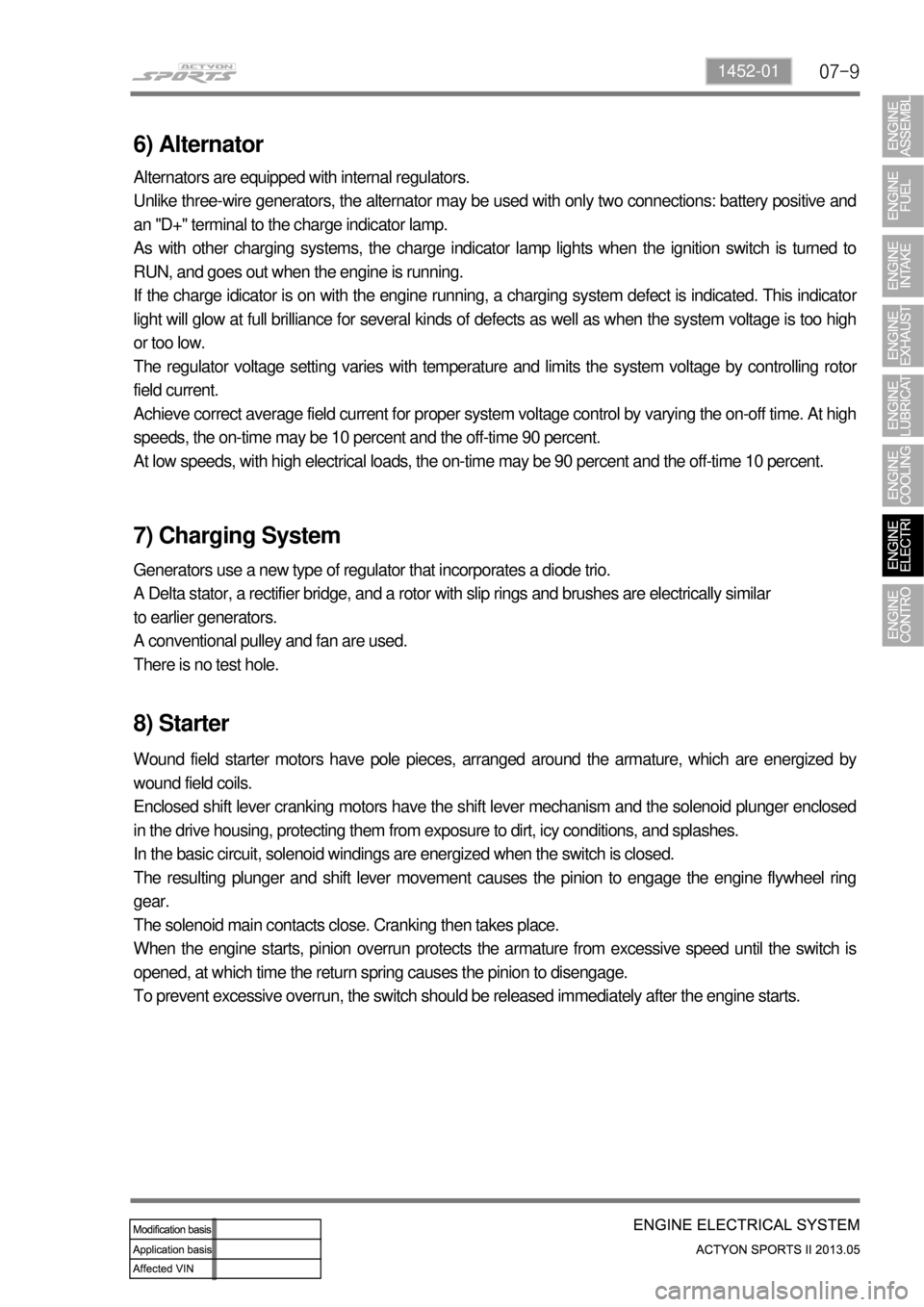Page 155 of 751
09-10
Alternator
The alternator charges the battery and
supplies power to each electric unit by
converting the mechanical energy to the
electrical energy.
1. SYSTEM DESCRIPTION
1) Overview
The charge system is designed to supply electrical energy to the vehicle while driving, and supplies a
constant direct current voltage by converting mechanical rotational movement to electrical energy.
The voltage regulator on the back of the alternator controls the generated voltage in all rotating ranges
and adjusts the system voltage according to the electric load and ambient temperature change.
2) System Layout (Locations)
Battery
It converts the chemical energy to the
electrical energy and supplies power to the
corresponding electric units when starting the
engine.
Page 157 of 751

09-12
Alternator (140 A)Alternator (120 A)
2) Charging
The alternator uses a new regulator which has three diodes. It consists of the delta stator, rectifier bridge,
slip ring and brush.
Charging time according to vehicle conditions and environment ▶
Specification: Charging a fully depleted high-
capacity battery takes twice or more as long as
charging a fully depleted battery for small
vehicles.
Temperature: The lower the temperature is, the
longer the time taken to charge the battery.
When connecting the battery charger to the cold
battery, the amount of current the battery can
accept initially is very small. As the battery gets
warmer, it can accept more current.
Charging capacity: Charging a battery with a low-capacity charger takes longer time than charging with
a high-capacity charger.
Charging status: Charging a fully depleted battery takes twice or more as long as charging a half-
depleted battery. Since the electrolyte in a fully depleted battery consists of nearly pure water and
conductor, only a very small amount of current can be accepted by the battery initially. The charging
current increases as the amount of acids in the electrolyte is increased by the charging current.
3) Output Characteristics
Page 242 of 751
15-42
Relay box in engine compartment
(13) PTC heater control
A. Overview
The supplementary electrical heater is installed in DI engine equipped vehicle as a basic equipment. The
PTC system is operated according to two temperature values measured at the coolant temperature
sensor and HFM sensor. This device is mounted in the heater air outlet and increase the temperature of
air to the passenger compartment. Because PTC system is heated by electrical power, high capacity
alternator is required. PTC does not operate during engine cranking, while the battery voltage is lower
than 11 V or during preheating process of glow plugs.
B. Components
HFM (intake air
temperature)
Coolant temperature
sensorPTC heater
PTC 2 relay (PTC
heater 2, 3)
PTC heater
3 (40A)
PTC heater
2 (40A)
PTC heater
1 (40A)
D20DTR ECU
PTC 1 relay
(PTC heater 1)
Page 298 of 751

07-91452-01
6) Alternator
Alternators are equipped with internal regulators.
Unlike three-wire generators, the alternator may be used with only two connections: battery positive and
an "D+" terminal to the charge indicator lamp.
As with other charging systems, the charge indicator lamp lights when the ignition switch is turned to
RUN, and goes out when the engine is running.
If the charge idicator is on with the engine running, a charging system defect is indicated. This indicato
r
light will glow at full brilliance for several kinds of defects as well as when the system voltage is too high
or too low.
The regulator voltage setting varies with temperature and limits the system voltage by controlling roto
r
field current.
Achieve correct average field current for proper system voltage control by varying the on-off time. At high
speeds, the on-time may be 10 percent and the off-time 90 percent.
At low speeds, with high electrical loads, the on-time may be 90 percent and the off-time 10 percent.
7) Charging System
Generators use a new type of regulator that incorporates a diode trio.
A Delta stator, a rectifier bridge, and a rotor with slip rings and brushes are electrically similar
to earlier generators.
A conventional pulley and fan are used.
There is no test hole.
8) Starter
Wound field starter motors have pole pieces, arranged around the armature, which are energized by
wound field coils.
Enclosed shift lever cranking motors have the shift lever mechanism and the solenoid plunger enclosed
in the drive housing, protecting them from exposure to dirt, icy conditions, and splashes.
In the basic circuit, solenoid windings are energized when the switch is closed.
The resulting plunger and shift lever movement causes the pinion to engage the engine flywheel ring
gear.
The solenoid main contacts close. Cranking then takes place.
When the engine starts, pinion overrun protects the armature from excessive speed until the switch is
opened, at which time the return spring causes the pinion to disengage.
To prevent excessive overrun, the switch should be released immediately after the engine starts.